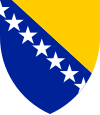Brčko district
| Brčko District Брчко Дистрикт |
|
| Brčko district | |

|

|
| flag | coat of arms |
|---|---|
| Location in Bosnia and Herzegovina | |
| status | Self-governing area (de facto); Condominium of FBiH and RS (de jure) |
| Capital | Brčko |
| Official languages | Bosnian , Croatian , Serbian |
| founding | March 8, 2000 |
| surface | 493 km² |
| Residents | 83,516 |
| Population density | 169.4 / km² |
| ISO 3166 | BA-BIH |
The Brčko district [ ˈbr̩tʃkɔː ] ( Cyrillic Брчко Дистрикт ) is a de facto self-governing area in northeastern Bosnia and Herzegovina . The area has an area of 493 km² and about 83,000 inhabitants.
As a special administrative area, it is officially administered in a condominium by the two entities of the country, the Federation of Bosnia and Herzegovina and the Republika Srpska . In fact, it is - largely in local self-government - directly under the control of the entire state. The administrative seat is the city of Brčko on the Sava .
According to the 2013 census, there are 83,516 inhabitants in the Brčko district. Of these, 35,381 identified themselves as Bosniaks (42.36%), 17,252 as Croats (20.66%) and 28,884 as Serbs (34.58%); 622 residents did not provide any information, 1,377 felt they belonged to other ethnicities.
population
| Ethnic group | 1961 census |
1971 census |
1981 census |
1991 census |
2013 census |
|---|---|---|---|---|---|
| Bosniaks / Muslims | 16,484 | 30.181 | 32,434 | 38,617 | 35,381 |
| Serbs | 17,897 | 17,709 | 16,707 | 18,128 | 28,884 |
| Croatians | 21,994 | 24,925 | 23,975 | 22,252 | 17,252 |
| Yugoslavs | 5,904 | 1,086 | 8,342 | 5,731 | - |
| Other / Not specified | 673 | 870 | 1.310 | 2,899 | 1999 |
| total | 62,952 | 74,771 | 82,768 | 87,627 | 83,516 |
history
The area formed the municipality of Brčko before the Bosnian War . In 1991 it had 87,332 inhabitants, of which 44% considered themselves Muslims (in terms of nationality), 25% Croatians and 21% Serbs . 10% called themselves “others”, including Roma.
Economically, the community was strongly developed mainly due to its convenient location. 34 companies including the important port industry offered good income opportunities.
During the war in the 1990s, parts of the area formed a narrow corridor under Serbian control, which was the only connection with the Serbian-controlled areas in the east for the west of the Republika Srpska and the area of the Republika Srpska Krajina . Other parts of the highly contested area were under Bosniak and Croatian control.
In April and May 1992, units of the Yugoslav People's Army and Serbian paramilitaries drove the Croatian and Bosniaks out of the city of Brčko. Many people were killed in war crimes. Here played Goran Jelisic , who himself "the Serbian Adolf called" and was sentenced to 40 years in prison for a leading role. Around 26,000 Serbian displaced persons and refugees came to the region during the war. Bosniaks and Croats formed their own communities (Brka and Ravno Brčko).
In the negotiations for the 1995 Dayton Treaty there was no agreement on the territorial affiliation of the city and region. For the Serbian side, the connecting corridor between the two otherwise separate parts of the Republika Srpska was and is necessary. The Bosniak side cited the fact that the city was predominantly inhabited by Bosniaks before the war. In addition, the inland port with trunk road and rail connections is the only access to the Danube region for the Federation.
The Brčko district was officially established on March 8, 2000 after it became clear that the two entities could not agree on an assignment of the area to one of the sides.
Web links
Individual evidence
- ↑ Description stanovništva, domaćinstava i stanova u i Bosni Hercegovini, 2013. Rezultati popisa. , P.56
- ↑ Nacionalni sastav stanovništva SFR Jugoslavije 1971 - Yugoslav Census 1971 , accessed on May 19, 2019
- ↑ Nacionalni sastav stanovništva SFR Jugoslavije 1981 - Yugoslav Census 1981 , Retrieved May 19, 2019
- ↑ a b Popis 2013 u BiH - Brčko District ( Bosnian / Croatian / Serbian ) Retrieved on May 19, 2019.
- ^ United Nations International Criminal Tribunal for the former Yugoslavia: Jelisić (IT-95-10)
Coordinates: 44 ° 52 ' N , 18 ° 47' E


